Individual Coursework: National Culture and MNC Strategy in CCM Essay
VerifiedAdded on 2022/12/05
|11
|2527
|71
Essay
AI Summary
This essay delves into the realm of cross-cultural management, specifically examining the influence of national culture on the strategic approaches of multinational corporations (MNCs). The paper reviews relevant academic literature, exploring how cultural differences impact communication, work styles, and motivation within a global business context. It analyzes key frameworks, including Hofstede's Cultural Dimensions Theory, Trompenaars' model, and Schein's culture model, to understand how these tools can be applied by MNCs to devise effective strategies. The essay covers various cultural dimensions such as power distance, individualism versus collectivism, uncertainty avoidance, masculinity versus femininity, and long-term versus short-term orientation. It also discusses the importance of understanding cultural values, artifacts, and basic assumptions in shaping organizational behavior and achieving business objectives across diverse cultural settings. The conclusion emphasizes the significance of cultural awareness for MNCs operating in the international arena, advocating for the adaptation of practices and methods to suit each cultural environment.

CROSS CULTURAL
MANAGEMENT
MANAGEMENT
Paraphrase This Document
Need a fresh take? Get an instant paraphrase of this document with our AI Paraphraser
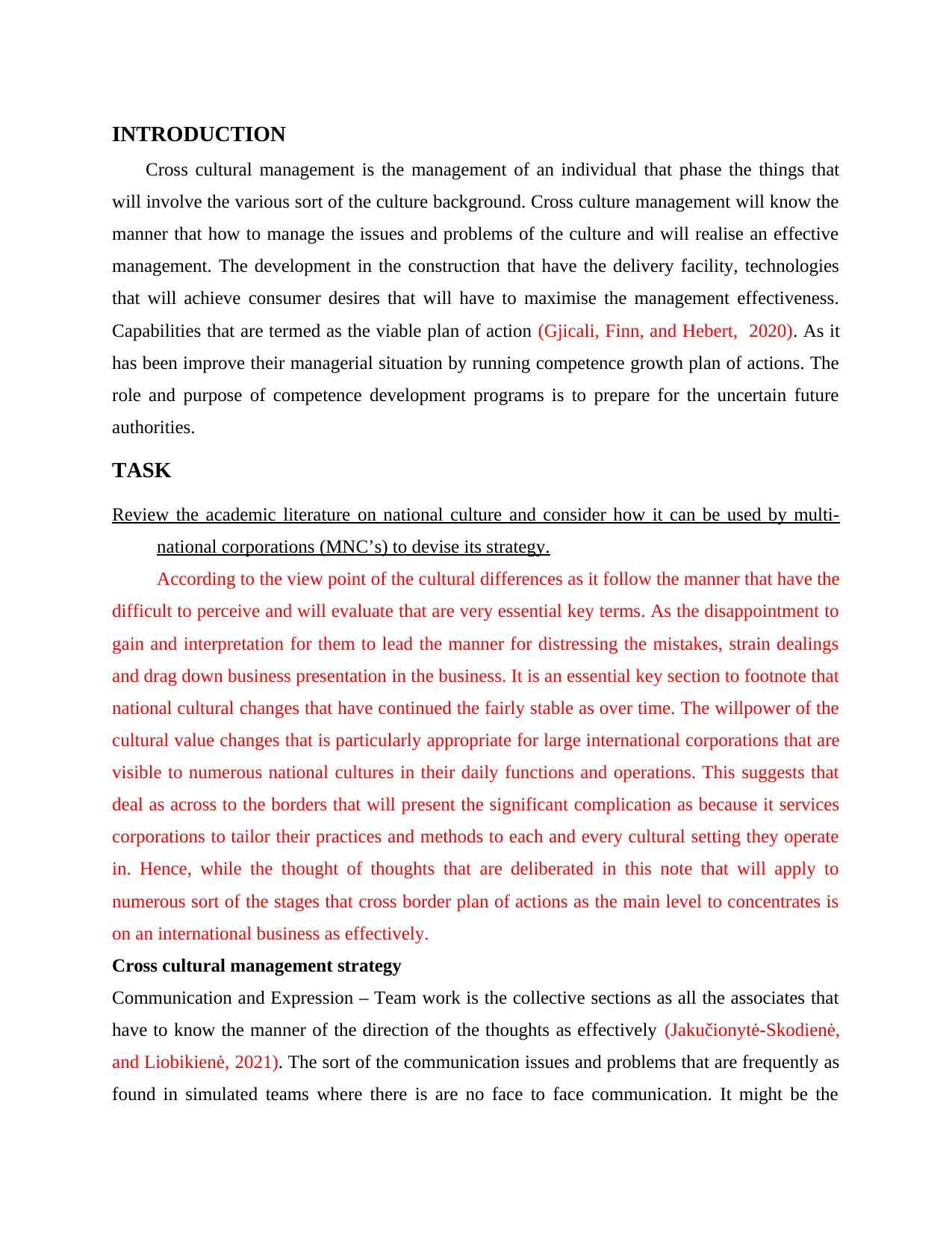
INTRODUCTION
Cross cultural management is the management of an individual that phase the things that
will involve the various sort of the culture background. Cross culture management will know the
manner that how to manage the issues and problems of the culture and will realise an effective
management. The development in the construction that have the delivery facility, technologies
that will achieve consumer desires that will have to maximise the management effectiveness.
Capabilities that are termed as the viable plan of action (Gjicali, Finn, and Hebert, 2020). As it
has been improve their managerial situation by running competence growth plan of actions. The
role and purpose of competence development programs is to prepare for the uncertain future
authorities.
TASK
Review the academic literature on national culture and consider how it can be used by multi-
national corporations (MNC’s) to devise its strategy.
According to the view point of the cultural differences as it follow the manner that have the
difficult to perceive and will evaluate that are very essential key terms. As the disappointment to
gain and interpretation for them to lead the manner for distressing the mistakes, strain dealings
and drag down business presentation in the business. It is an essential key section to footnote that
national cultural changes that have continued the fairly stable as over time. The willpower of the
cultural value changes that is particularly appropriate for large international corporations that are
visible to numerous national cultures in their daily functions and operations. This suggests that
deal as across to the borders that will present the significant complication as because it services
corporations to tailor their practices and methods to each and every cultural setting they operate
in. Hence, while the thought of thoughts that are deliberated in this note that will apply to
numerous sort of the stages that cross border plan of actions as the main level to concentrates is
on an international business as effectively.
Cross cultural management strategy
Communication and Expression – Team work is the collective sections as all the associates that
have to know the manner of the direction of the thoughts as effectively (Jakučionytė-Skodienė,
and Liobikienė, 2021). The sort of the communication issues and problems that are frequently as
found in simulated teams where there is are no face to face communication. It might be the
Cross cultural management is the management of an individual that phase the things that
will involve the various sort of the culture background. Cross culture management will know the
manner that how to manage the issues and problems of the culture and will realise an effective
management. The development in the construction that have the delivery facility, technologies
that will achieve consumer desires that will have to maximise the management effectiveness.
Capabilities that are termed as the viable plan of action (Gjicali, Finn, and Hebert, 2020). As it
has been improve their managerial situation by running competence growth plan of actions. The
role and purpose of competence development programs is to prepare for the uncertain future
authorities.
TASK
Review the academic literature on national culture and consider how it can be used by multi-
national corporations (MNC’s) to devise its strategy.
According to the view point of the cultural differences as it follow the manner that have the
difficult to perceive and will evaluate that are very essential key terms. As the disappointment to
gain and interpretation for them to lead the manner for distressing the mistakes, strain dealings
and drag down business presentation in the business. It is an essential key section to footnote that
national cultural changes that have continued the fairly stable as over time. The willpower of the
cultural value changes that is particularly appropriate for large international corporations that are
visible to numerous national cultures in their daily functions and operations. This suggests that
deal as across to the borders that will present the significant complication as because it services
corporations to tailor their practices and methods to each and every cultural setting they operate
in. Hence, while the thought of thoughts that are deliberated in this note that will apply to
numerous sort of the stages that cross border plan of actions as the main level to concentrates is
on an international business as effectively.
Cross cultural management strategy
Communication and Expression – Team work is the collective sections as all the associates that
have to know the manner of the direction of the thoughts as effectively (Jakučionytė-Skodienė,
and Liobikienė, 2021). The sort of the communication issues and problems that are frequently as
found in simulated teams where there is are no face to face communication. It might be the
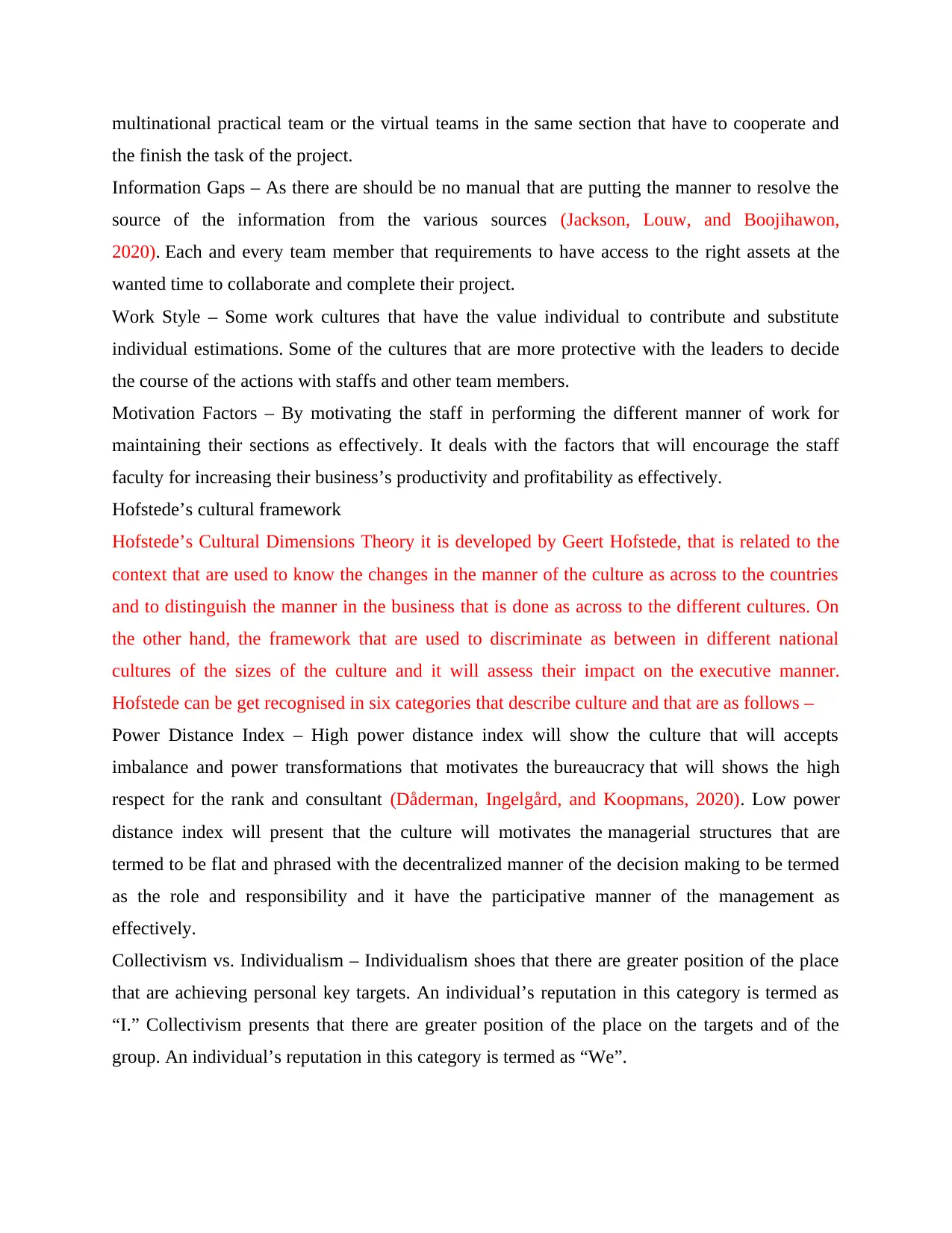
multinational practical team or the virtual teams in the same section that have to cooperate and
the finish the task of the project.
Information Gaps – As there are should be no manual that are putting the manner to resolve the
source of the information from the various sources (Jackson, Louw, and Boojihawon,
2020). Each and every team member that requirements to have access to the right assets at the
wanted time to collaborate and complete their project.
Work Style – Some work cultures that have the value individual to contribute and substitute
individual estimations. Some of the cultures that are more protective with the leaders to decide
the course of the actions with staffs and other team members.
Motivation Factors – By motivating the staff in performing the different manner of work for
maintaining their sections as effectively. It deals with the factors that will encourage the staff
faculty for increasing their business’s productivity and profitability as effectively.
Hofstede’s cultural framework
Hofstede’s Cultural Dimensions Theory it is developed by Geert Hofstede, that is related to the
context that are used to know the changes in the manner of the culture as across to the countries
and to distinguish the manner in the business that is done as across to the different cultures. On
the other hand, the framework that are used to discriminate as between in different national
cultures of the sizes of the culture and it will assess their impact on the executive manner.
Hofstede can be get recognised in six categories that describe culture and that are as follows –
Power Distance Index – High power distance index will show the culture that will accepts
imbalance and power transformations that motivates the bureaucracy that will shows the high
respect for the rank and consultant (Dåderman, Ingelgård, and Koopmans, 2020). Low power
distance index will present that the culture will motivates the managerial structures that are
termed to be flat and phrased with the decentralized manner of the decision making to be termed
as the role and responsibility and it have the participative manner of the management as
effectively.
Collectivism vs. Individualism – Individualism shoes that there are greater position of the place
that are achieving personal key targets. An individual’s reputation in this category is termed as
“I.” Collectivism presents that there are greater position of the place on the targets and of the
group. An individual’s reputation in this category is termed as “We”.
the finish the task of the project.
Information Gaps – As there are should be no manual that are putting the manner to resolve the
source of the information from the various sources (Jackson, Louw, and Boojihawon,
2020). Each and every team member that requirements to have access to the right assets at the
wanted time to collaborate and complete their project.
Work Style – Some work cultures that have the value individual to contribute and substitute
individual estimations. Some of the cultures that are more protective with the leaders to decide
the course of the actions with staffs and other team members.
Motivation Factors – By motivating the staff in performing the different manner of work for
maintaining their sections as effectively. It deals with the factors that will encourage the staff
faculty for increasing their business’s productivity and profitability as effectively.
Hofstede’s cultural framework
Hofstede’s Cultural Dimensions Theory it is developed by Geert Hofstede, that is related to the
context that are used to know the changes in the manner of the culture as across to the countries
and to distinguish the manner in the business that is done as across to the different cultures. On
the other hand, the framework that are used to discriminate as between in different national
cultures of the sizes of the culture and it will assess their impact on the executive manner.
Hofstede can be get recognised in six categories that describe culture and that are as follows –
Power Distance Index – High power distance index will show the culture that will accepts
imbalance and power transformations that motivates the bureaucracy that will shows the high
respect for the rank and consultant (Dåderman, Ingelgård, and Koopmans, 2020). Low power
distance index will present that the culture will motivates the managerial structures that are
termed to be flat and phrased with the decentralized manner of the decision making to be termed
as the role and responsibility and it have the participative manner of the management as
effectively.
Collectivism vs. Individualism – Individualism shoes that there are greater position of the place
that are achieving personal key targets. An individual’s reputation in this category is termed as
“I.” Collectivism presents that there are greater position of the place on the targets and of the
group. An individual’s reputation in this category is termed as “We”.
⊘ This is a preview!⊘
Do you want full access?
Subscribe today to unlock all pages.

Trusted by 1+ million students worldwide
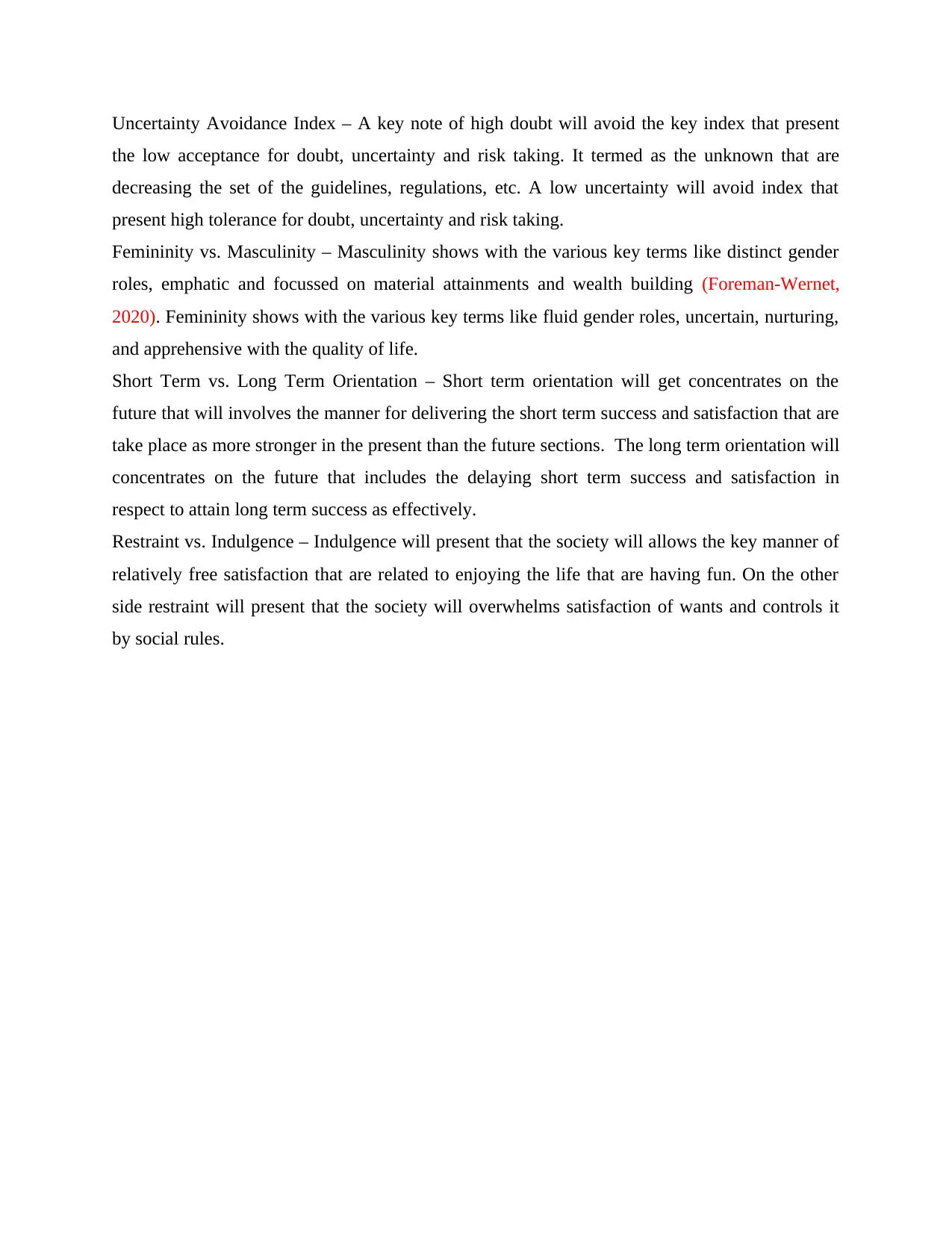
Uncertainty Avoidance Index – A key note of high doubt will avoid the key index that present
the low acceptance for doubt, uncertainty and risk taking. It termed as the unknown that are
decreasing the set of the guidelines, regulations, etc. A low uncertainty will avoid index that
present high tolerance for doubt, uncertainty and risk taking.
Femininity vs. Masculinity – Masculinity shows with the various key terms like distinct gender
roles, emphatic and focussed on material attainments and wealth building (Foreman-Wernet,
2020). Femininity shows with the various key terms like fluid gender roles, uncertain, nurturing,
and apprehensive with the quality of life.
Short Term vs. Long Term Orientation – Short term orientation will get concentrates on the
future that will involves the manner for delivering the short term success and satisfaction that are
take place as more stronger in the present than the future sections. The long term orientation will
concentrates on the future that includes the delaying short term success and satisfaction in
respect to attain long term success as effectively.
Restraint vs. Indulgence – Indulgence will present that the society will allows the key manner of
relatively free satisfaction that are related to enjoying the life that are having fun. On the other
side restraint will present that the society will overwhelms satisfaction of wants and controls it
by social rules.
the low acceptance for doubt, uncertainty and risk taking. It termed as the unknown that are
decreasing the set of the guidelines, regulations, etc. A low uncertainty will avoid index that
present high tolerance for doubt, uncertainty and risk taking.
Femininity vs. Masculinity – Masculinity shows with the various key terms like distinct gender
roles, emphatic and focussed on material attainments and wealth building (Foreman-Wernet,
2020). Femininity shows with the various key terms like fluid gender roles, uncertain, nurturing,
and apprehensive with the quality of life.
Short Term vs. Long Term Orientation – Short term orientation will get concentrates on the
future that will involves the manner for delivering the short term success and satisfaction that are
take place as more stronger in the present than the future sections. The long term orientation will
concentrates on the future that includes the delaying short term success and satisfaction in
respect to attain long term success as effectively.
Restraint vs. Indulgence – Indulgence will present that the society will allows the key manner of
relatively free satisfaction that are related to enjoying the life that are having fun. On the other
side restraint will present that the society will overwhelms satisfaction of wants and controls it
by social rules.
Paraphrase This Document
Need a fresh take? Get an instant paraphrase of this document with our AI Paraphraser
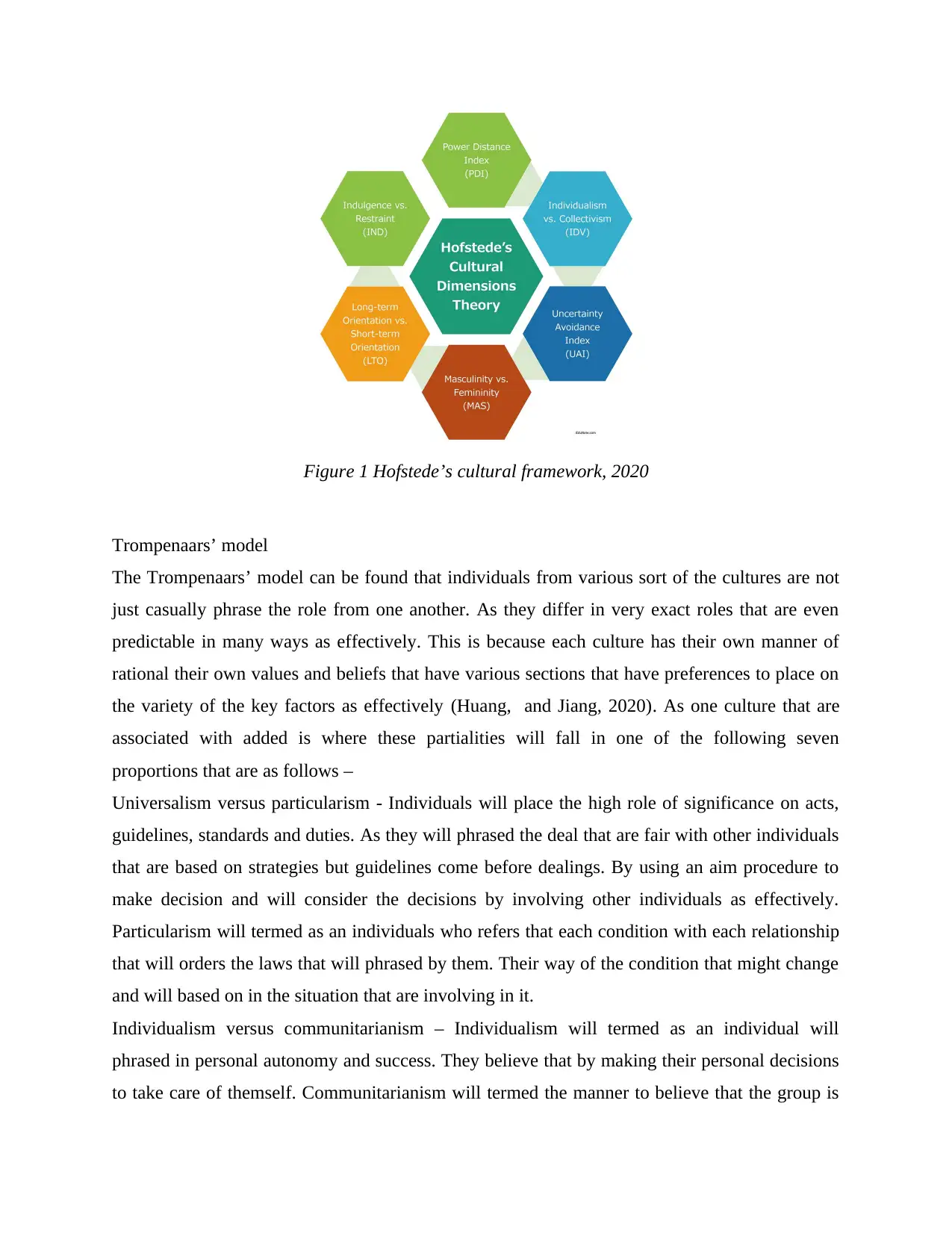
Figure 1 Hofstede’s cultural framework, 2020
Trompenaars’ model
The Trompenaars’ model can be found that individuals from various sort of the cultures are not
just casually phrase the role from one another. As they differ in very exact roles that are even
predictable in many ways as effectively. This is because each culture has their own manner of
rational their own values and beliefs that have various sections that have preferences to place on
the variety of the key factors as effectively (Huang, and Jiang, 2020). As one culture that are
associated with added is where these partialities will fall in one of the following seven
proportions that are as follows –
Universalism versus particularism - Individuals will place the high role of significance on acts,
guidelines, standards and duties. As they will phrased the deal that are fair with other individuals
that are based on strategies but guidelines come before dealings. By using an aim procedure to
make decision and will consider the decisions by involving other individuals as effectively.
Particularism will termed as an individuals who refers that each condition with each relationship
that will orders the laws that will phrased by them. Their way of the condition that might change
and will based on in the situation that are involving in it.
Individualism versus communitarianism – Individualism will termed as an individual will
phrased in personal autonomy and success. They believe that by making their personal decisions
to take care of themself. Communitarianism will termed the manner to believe that the group is
Trompenaars’ model
The Trompenaars’ model can be found that individuals from various sort of the cultures are not
just casually phrase the role from one another. As they differ in very exact roles that are even
predictable in many ways as effectively. This is because each culture has their own manner of
rational their own values and beliefs that have various sections that have preferences to place on
the variety of the key factors as effectively (Huang, and Jiang, 2020). As one culture that are
associated with added is where these partialities will fall in one of the following seven
proportions that are as follows –
Universalism versus particularism - Individuals will place the high role of significance on acts,
guidelines, standards and duties. As they will phrased the deal that are fair with other individuals
that are based on strategies but guidelines come before dealings. By using an aim procedure to
make decision and will consider the decisions by involving other individuals as effectively.
Particularism will termed as an individuals who refers that each condition with each relationship
that will orders the laws that will phrased by them. Their way of the condition that might change
and will based on in the situation that are involving in it.
Individualism versus communitarianism – Individualism will termed as an individual will
phrased in personal autonomy and success. They believe that by making their personal decisions
to take care of themself. Communitarianism will termed the manner to believe that the group is
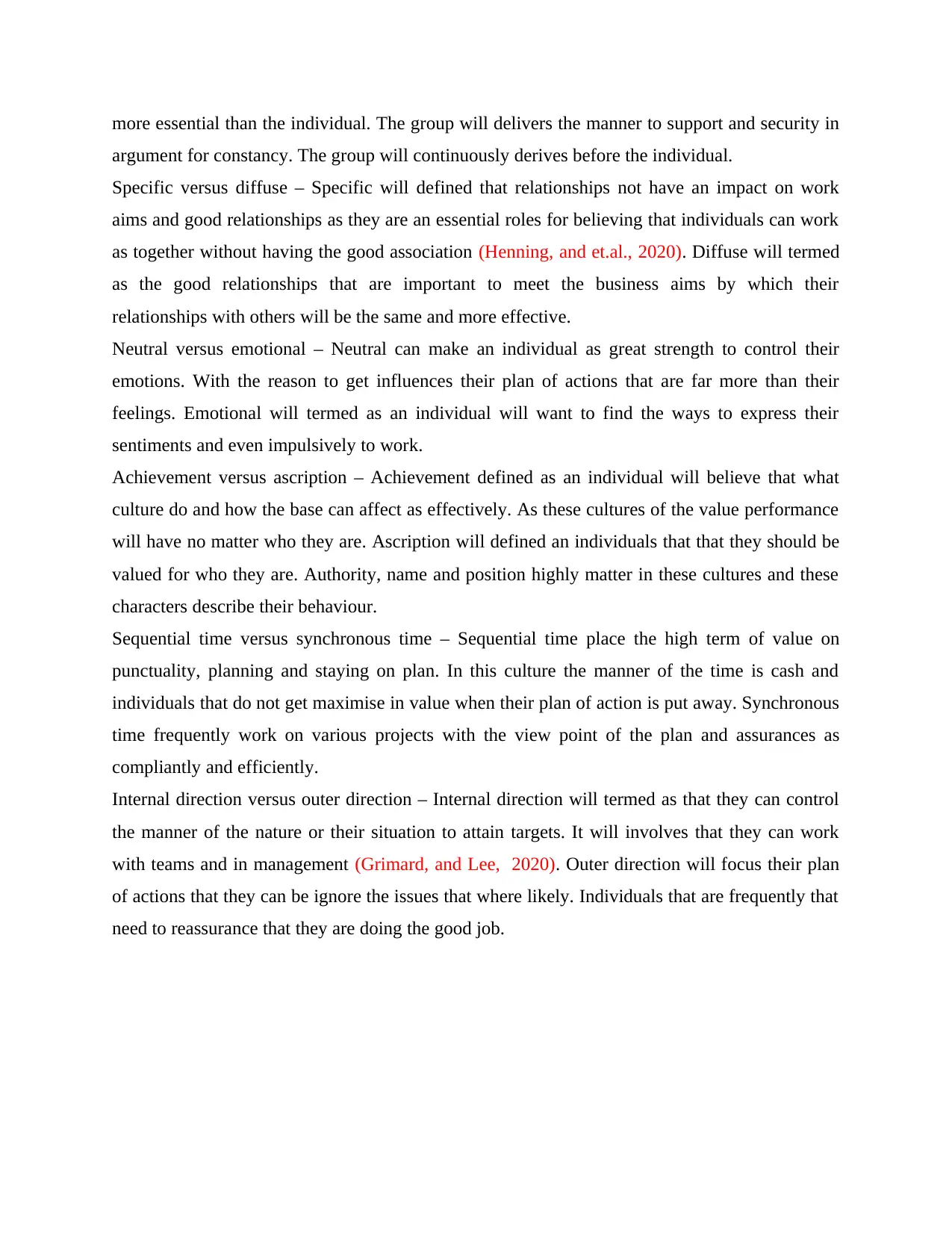
more essential than the individual. The group will delivers the manner to support and security in
argument for constancy. The group will continuously derives before the individual.
Specific versus diffuse – Specific will defined that relationships not have an impact on work
aims and good relationships as they are an essential roles for believing that individuals can work
as together without having the good association (Henning, and et.al., 2020). Diffuse will termed
as the good relationships that are important to meet the business aims by which their
relationships with others will be the same and more effective.
Neutral versus emotional – Neutral can make an individual as great strength to control their
emotions. With the reason to get influences their plan of actions that are far more than their
feelings. Emotional will termed as an individual will want to find the ways to express their
sentiments and even impulsively to work.
Achievement versus ascription – Achievement defined as an individual will believe that what
culture do and how the base can affect as effectively. As these cultures of the value performance
will have no matter who they are. Ascription will defined an individuals that that they should be
valued for who they are. Authority, name and position highly matter in these cultures and these
characters describe their behaviour.
Sequential time versus synchronous time – Sequential time place the high term of value on
punctuality, planning and staying on plan. In this culture the manner of the time is cash and
individuals that do not get maximise in value when their plan of action is put away. Synchronous
time frequently work on various projects with the view point of the plan and assurances as
compliantly and efficiently.
Internal direction versus outer direction – Internal direction will termed as that they can control
the manner of the nature or their situation to attain targets. It will involves that they can work
with teams and in management (Grimard, and Lee, 2020). Outer direction will focus their plan
of actions that they can be ignore the issues that where likely. Individuals that are frequently that
need to reassurance that they are doing the good job.
argument for constancy. The group will continuously derives before the individual.
Specific versus diffuse – Specific will defined that relationships not have an impact on work
aims and good relationships as they are an essential roles for believing that individuals can work
as together without having the good association (Henning, and et.al., 2020). Diffuse will termed
as the good relationships that are important to meet the business aims by which their
relationships with others will be the same and more effective.
Neutral versus emotional – Neutral can make an individual as great strength to control their
emotions. With the reason to get influences their plan of actions that are far more than their
feelings. Emotional will termed as an individual will want to find the ways to express their
sentiments and even impulsively to work.
Achievement versus ascription – Achievement defined as an individual will believe that what
culture do and how the base can affect as effectively. As these cultures of the value performance
will have no matter who they are. Ascription will defined an individuals that that they should be
valued for who they are. Authority, name and position highly matter in these cultures and these
characters describe their behaviour.
Sequential time versus synchronous time – Sequential time place the high term of value on
punctuality, planning and staying on plan. In this culture the manner of the time is cash and
individuals that do not get maximise in value when their plan of action is put away. Synchronous
time frequently work on various projects with the view point of the plan and assurances as
compliantly and efficiently.
Internal direction versus outer direction – Internal direction will termed as that they can control
the manner of the nature or their situation to attain targets. It will involves that they can work
with teams and in management (Grimard, and Lee, 2020). Outer direction will focus their plan
of actions that they can be ignore the issues that where likely. Individuals that are frequently that
need to reassurance that they are doing the good job.
⊘ This is a preview!⊘
Do you want full access?
Subscribe today to unlock all pages.

Trusted by 1+ million students worldwide
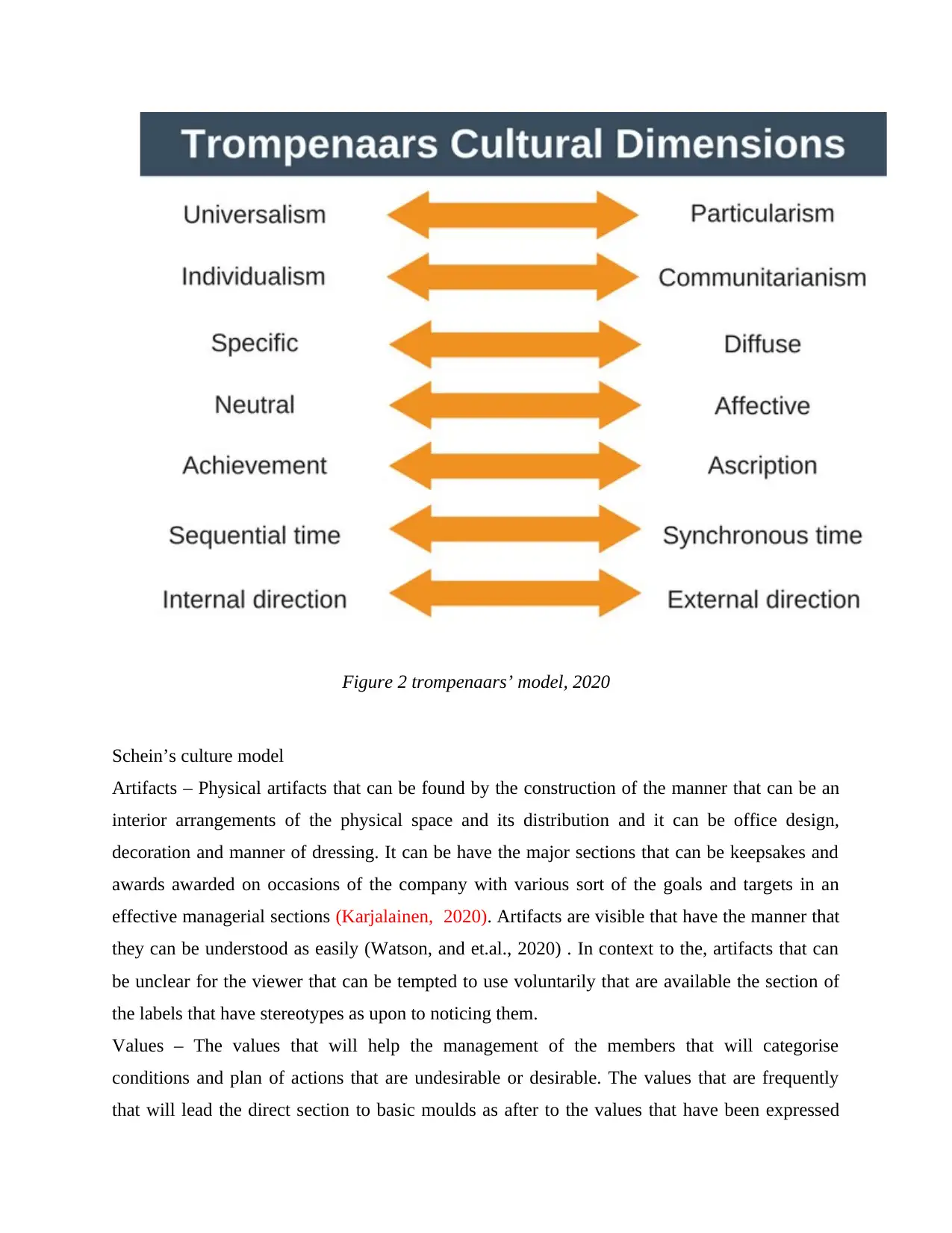
Figure 2 trompenaars’ model, 2020
Schein’s culture model
Artifacts – Physical artifacts that can be found by the construction of the manner that can be an
interior arrangements of the physical space and its distribution and it can be office design,
decoration and manner of dressing. It can be have the major sections that can be keepsakes and
awards awarded on occasions of the company with various sort of the goals and targets in an
effective managerial sections (Karjalainen, 2020). Artifacts are visible that have the manner that
they can be understood as easily (Watson, and et.al., 2020) . In context to the, artifacts that can
be unclear for the viewer that can be tempted to use voluntarily that are available the section of
the labels that have stereotypes as upon to noticing them.
Values – The values that will help the management of the members that will categorise
conditions and plan of actions that are undesirable or desirable. The values that are frequently
that will lead the direct section to basic moulds as after to the values that have been expressed
Schein’s culture model
Artifacts – Physical artifacts that can be found by the construction of the manner that can be an
interior arrangements of the physical space and its distribution and it can be office design,
decoration and manner of dressing. It can be have the major sections that can be keepsakes and
awards awarded on occasions of the company with various sort of the goals and targets in an
effective managerial sections (Karjalainen, 2020). Artifacts are visible that have the manner that
they can be understood as easily (Watson, and et.al., 2020) . In context to the, artifacts that can
be unclear for the viewer that can be tempted to use voluntarily that are available the section of
the labels that have stereotypes as upon to noticing them.
Values – The values that will help the management of the members that will categorise
conditions and plan of actions that are undesirable or desirable. The values that are frequently
that will lead the direct section to basic moulds as after to the values that have been expressed
Paraphrase This Document
Need a fresh take? Get an instant paraphrase of this document with our AI Paraphraser
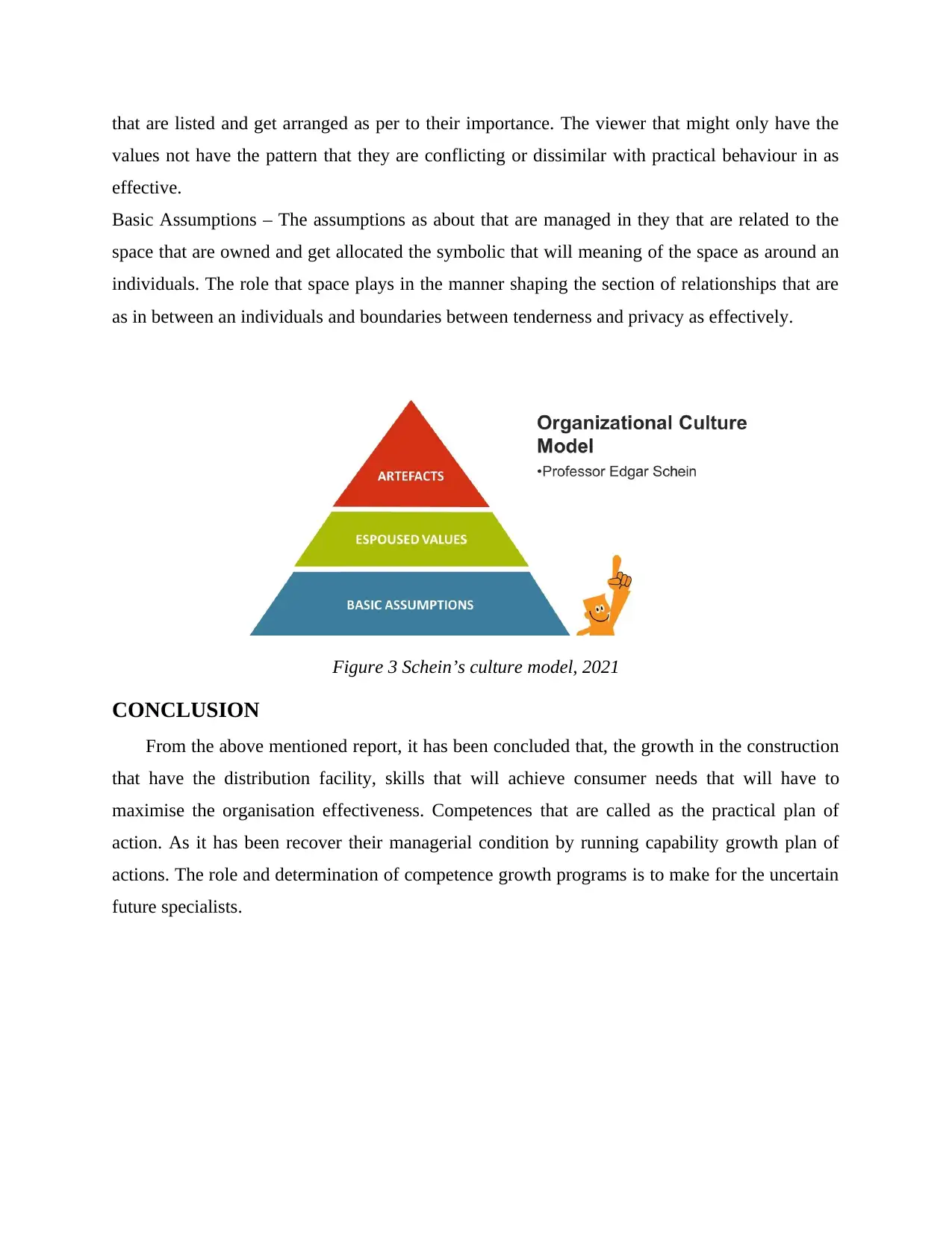
that are listed and get arranged as per to their importance. The viewer that might only have the
values not have the pattern that they are conflicting or dissimilar with practical behaviour in as
effective.
Basic Assumptions – The assumptions as about that are managed in they that are related to the
space that are owned and get allocated the symbolic that will meaning of the space as around an
individuals. The role that space plays in the manner shaping the section of relationships that are
as in between an individuals and boundaries between tenderness and privacy as effectively.
Figure 3 Schein’s culture model, 2021
CONCLUSION
From the above mentioned report, it has been concluded that, the growth in the construction
that have the distribution facility, skills that will achieve consumer needs that will have to
maximise the organisation effectiveness. Competences that are called as the practical plan of
action. As it has been recover their managerial condition by running capability growth plan of
actions. The role and determination of competence growth programs is to make for the uncertain
future specialists.
values not have the pattern that they are conflicting or dissimilar with practical behaviour in as
effective.
Basic Assumptions – The assumptions as about that are managed in they that are related to the
space that are owned and get allocated the symbolic that will meaning of the space as around an
individuals. The role that space plays in the manner shaping the section of relationships that are
as in between an individuals and boundaries between tenderness and privacy as effectively.
Figure 3 Schein’s culture model, 2021
CONCLUSION
From the above mentioned report, it has been concluded that, the growth in the construction
that have the distribution facility, skills that will achieve consumer needs that will have to
maximise the organisation effectiveness. Competences that are called as the practical plan of
action. As it has been recover their managerial condition by running capability growth plan of
actions. The role and determination of competence growth programs is to make for the uncertain
future specialists.
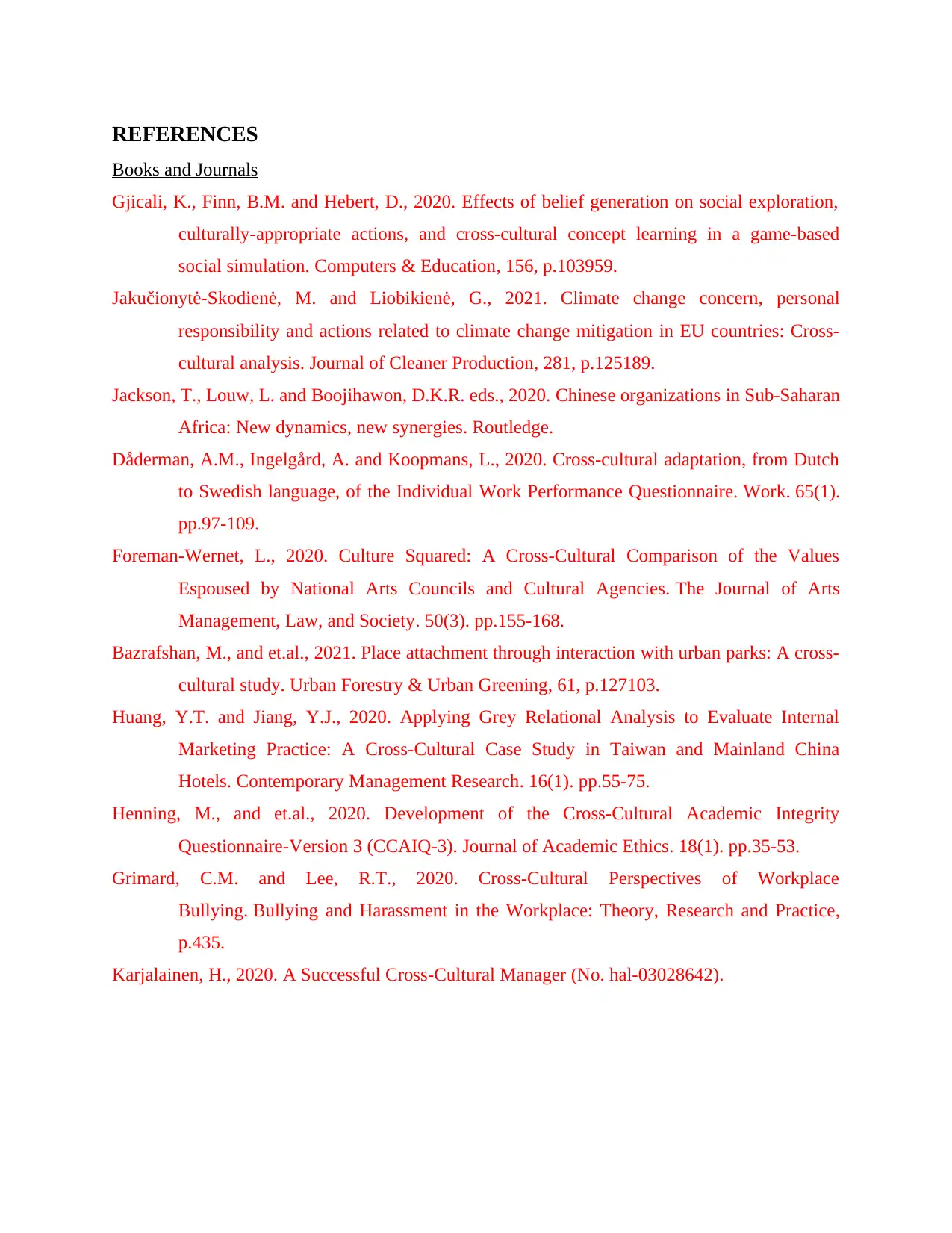
REFERENCES
Books and Journals
Gjicali, K., Finn, B.M. and Hebert, D., 2020. Effects of belief generation on social exploration,
culturally-appropriate actions, and cross-cultural concept learning in a game-based
social simulation. Computers & Education, 156, p.103959.
Jakučionytė-Skodienė, M. and Liobikienė, G., 2021. Climate change concern, personal
responsibility and actions related to climate change mitigation in EU countries: Cross-
cultural analysis. Journal of Cleaner Production, 281, p.125189.
Jackson, T., Louw, L. and Boojihawon, D.K.R. eds., 2020. Chinese organizations in Sub-Saharan
Africa: New dynamics, new synergies. Routledge.
Dåderman, A.M., Ingelgård, A. and Koopmans, L., 2020. Cross-cultural adaptation, from Dutch
to Swedish language, of the Individual Work Performance Questionnaire. Work. 65(1).
pp.97-109.
Foreman-Wernet, L., 2020. Culture Squared: A Cross-Cultural Comparison of the Values
Espoused by National Arts Councils and Cultural Agencies. The Journal of Arts
Management, Law, and Society. 50(3). pp.155-168.
Bazrafshan, M., and et.al., 2021. Place attachment through interaction with urban parks: A cross-
cultural study. Urban Forestry & Urban Greening, 61, p.127103.
Huang, Y.T. and Jiang, Y.J., 2020. Applying Grey Relational Analysis to Evaluate Internal
Marketing Practice: A Cross-Cultural Case Study in Taiwan and Mainland China
Hotels. Contemporary Management Research. 16(1). pp.55-75.
Henning, M., and et.al., 2020. Development of the Cross-Cultural Academic Integrity
Questionnaire-Version 3 (CCAIQ-3). Journal of Academic Ethics. 18(1). pp.35-53.
Grimard, C.M. and Lee, R.T., 2020. Cross-Cultural Perspectives of Workplace
Bullying. Bullying and Harassment in the Workplace: Theory, Research and Practice,
p.435.
Karjalainen, H., 2020. A Successful Cross-Cultural Manager (No. hal-03028642).
Books and Journals
Gjicali, K., Finn, B.M. and Hebert, D., 2020. Effects of belief generation on social exploration,
culturally-appropriate actions, and cross-cultural concept learning in a game-based
social simulation. Computers & Education, 156, p.103959.
Jakučionytė-Skodienė, M. and Liobikienė, G., 2021. Climate change concern, personal
responsibility and actions related to climate change mitigation in EU countries: Cross-
cultural analysis. Journal of Cleaner Production, 281, p.125189.
Jackson, T., Louw, L. and Boojihawon, D.K.R. eds., 2020. Chinese organizations in Sub-Saharan
Africa: New dynamics, new synergies. Routledge.
Dåderman, A.M., Ingelgård, A. and Koopmans, L., 2020. Cross-cultural adaptation, from Dutch
to Swedish language, of the Individual Work Performance Questionnaire. Work. 65(1).
pp.97-109.
Foreman-Wernet, L., 2020. Culture Squared: A Cross-Cultural Comparison of the Values
Espoused by National Arts Councils and Cultural Agencies. The Journal of Arts
Management, Law, and Society. 50(3). pp.155-168.
Bazrafshan, M., and et.al., 2021. Place attachment through interaction with urban parks: A cross-
cultural study. Urban Forestry & Urban Greening, 61, p.127103.
Huang, Y.T. and Jiang, Y.J., 2020. Applying Grey Relational Analysis to Evaluate Internal
Marketing Practice: A Cross-Cultural Case Study in Taiwan and Mainland China
Hotels. Contemporary Management Research. 16(1). pp.55-75.
Henning, M., and et.al., 2020. Development of the Cross-Cultural Academic Integrity
Questionnaire-Version 3 (CCAIQ-3). Journal of Academic Ethics. 18(1). pp.35-53.
Grimard, C.M. and Lee, R.T., 2020. Cross-Cultural Perspectives of Workplace
Bullying. Bullying and Harassment in the Workplace: Theory, Research and Practice,
p.435.
Karjalainen, H., 2020. A Successful Cross-Cultural Manager (No. hal-03028642).
⊘ This is a preview!⊘
Do you want full access?
Subscribe today to unlock all pages.

Trusted by 1+ million students worldwide

Paraphrase This Document
Need a fresh take? Get an instant paraphrase of this document with our AI Paraphraser

1 out of 11
Related Documents
Your All-in-One AI-Powered Toolkit for Academic Success.
+13062052269
info@desklib.com
Available 24*7 on WhatsApp / Email
![[object Object]](/_next/static/media/star-bottom.7253800d.svg)
Unlock your academic potential
Copyright © 2020–2025 A2Z Services. All Rights Reserved. Developed and managed by ZUCOL.




